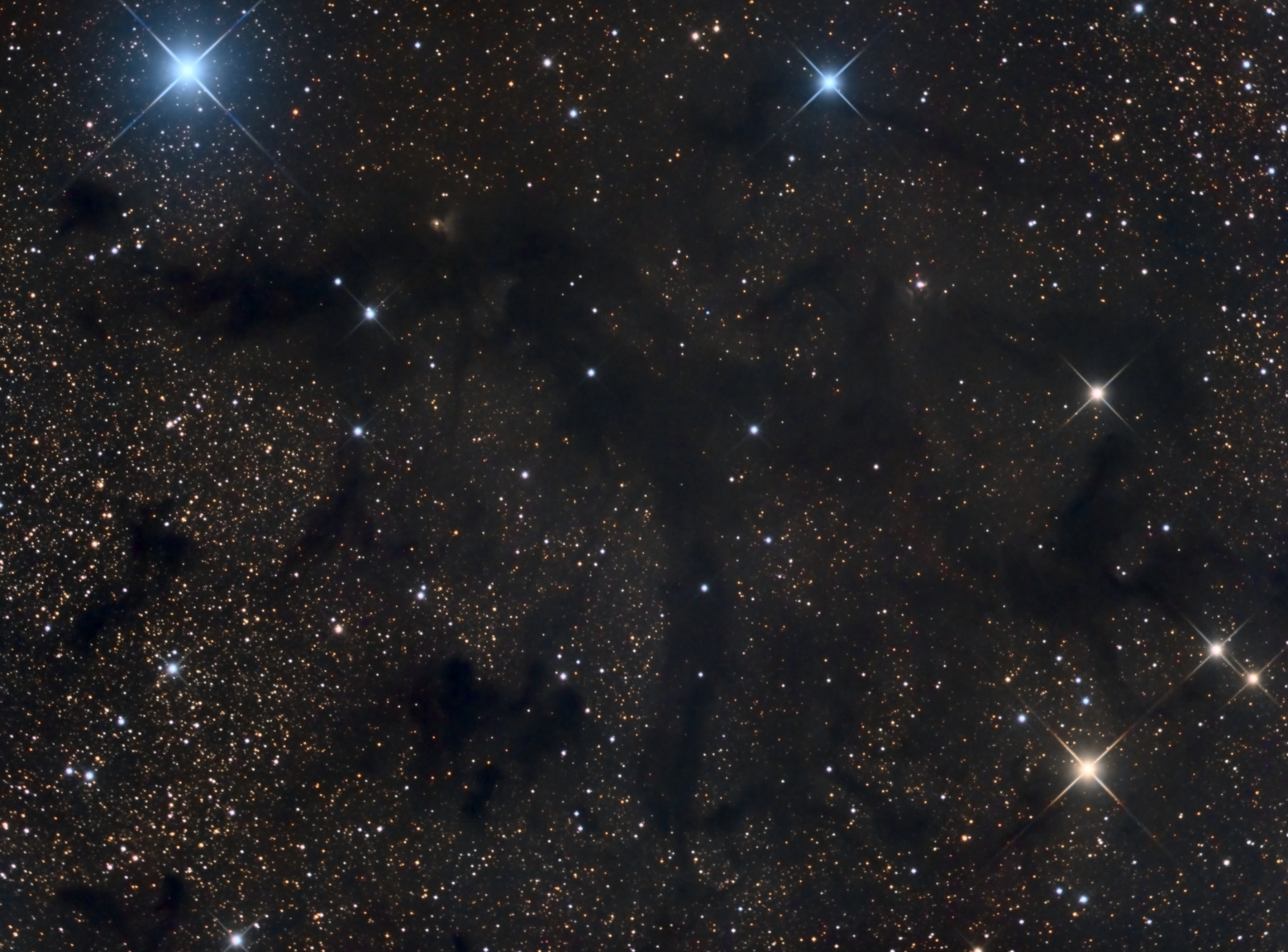LDN673, Dark Nebula
 Click image for full size version
Click image for full size version
September 14, 2015
Sometimes it is what you don’t see that makes a picture interesting. In this case, star light in the thick of the Milky Way is being obliterated by dust and soot that makes up the dark lanes of our galaxy. LDN673 lies in the direction of Aquila, the Eagle, in a molecular cloud of almost incomprehensible proportions: it is around 67 trillion kilometers across, and it is between 300-600 light years from Earth. Such molecular clouds are places where stars are born, and there may be enough matter in this regions to form hundreds of thousands of new stars.
If you look between and a little below the two bright blue stars you can see a small red nebula, RNO109. Another interesting object is upper right of centre, flanked by a pair of faint reddish stars in the 10 and 11 o’clock positions — this is a Herbig-Haro object, HH32. These objects form when jets of material ejected by a star clear away surrounding dark material, allowing the star to be visible from Earth.
Tekkies:
SBIG STL-11000M camera, Baader LRGB filters, 10″ f/6.8 ASA astrograph, Paramount MX. Guided with STL-11000’s external guider and 80 mm f/6 Stellar-Vue refractor. Acquisition and guiding with TheSkyX. Focusing with FocusMax. Automation with CCDCommander. Calibration, cosmetic correction, registration, integration and all processing in PixInsight. Shot from my SkyShed in Guelph, Ontario. No moon, good to very good transparency and fair to average seeing throughout acquisition.
8x15m R, 8x15m G, 12x15m B and 25x10m L unbinned frames (total=11hr10m).
Initial Processing:
L, R, G and B masters were cropped and processed separately with DBE. R, G and B were combined to make an RGB image which was processed with DBE and ColourCalibration. MultiscaleLinearTransform was applied to reduce the noise prior to stretching. HistogramTransformation was applied to make a pleasing yet bright image. TGV Noise was applied and the image was re-stretched to reset the black point.
Synthetic Luminance:
Creation and cleanup: The cleaned up L, R,G and B masters were combined using the ImageIntegration tool (average, additive with scaling, noise evaluation, iterative K-sigma / biweight midvariance, no pixel rejection).
Linear Noise Reduction: MultiscaleLinearTransform was applied to reduce the noise prior to stretching.
Stretching: HistogramTransformation was applied to make a pleasing yet bright image. TGVDenoise was applied in L-ab mode and HistogramTransformation was applied to reset the black point.
Combining SynthL with HaRGB:
The luminance channel of the RGB image was extracted, processed and then added back into the RGB image as follows:
1. Extract luminance from the RGB image.
2. Apply LinearFit using SynthL as the reference.
3. Use ChannelCombination in Lab mode to replace the RGB’s luminance with the fitted luminance from step 2.
4. LRGBCombine was then used to make a SynthLRGB image.
Final Processing
Magenta artifacts on a couple of bright stars were corrected by reducing saturation through a magenta-correction mask. The magenta-correction mask was made by multiplying the output of the ColorMask script (set to magenta) with the deconvolution local support file and then blurring slightly using convolution. This mask was black everywhere except where the bright magenta artifacts were located. SCNR was applied and curves were applied to increase contrast overall, increase colour saturation in the stars and decrease colour saturation elsewhere.
Image scale is about 1.1 arcsec per pixel for this camera / telescope combination.






Top image!
These dark nebulae are tough targets – this one certainly repaid the time invested.
Mark